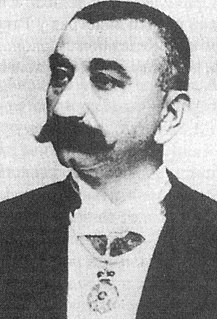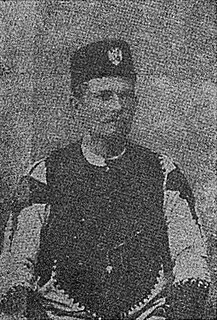 W
WThe Serbian Revolutionary Organization or Serbian Chetnik Organization was a revolutionary organization with the aim of liberation of Old Serbia from the Ottoman Empire. Its Central Committee was established in 1902, while the Serbian Committee was established in September 1903 in Belgrade, by the combined Central Boards of Belgrade, Vranje, Skopje and Bitola. Its armed wing was activated in 1904. Among the architects were members of the Saint Sava society, Army Staff and Ministry of Foreign Affairs. It operated during the Struggle for Macedonia, a series of social, political, cultural and military conflicts in the region of Macedonia; its operations are known as Serb Action in Macedonia.
 W
WLuka Ćelović also known as Luka Ćelović-Trebinjac was a Serbian businessman, merchant and rentier. At the beginning of the 20th century, he was one of the most influential people in Serbia, a patriot and a great benefactor, also a philanthropist of education. He was the first president of the Belgrade Cooperative. In 1902, with Milorad Gođevac, he founded the Serbian Chetnik Organization in Belgrade.
 W
WDragomir "Dejan" Popović Jekić, known as "Voivode Dejan" during the struggle for Old Serbia and Macedonia, was a chemist and Serbian Chetnik commander (vojvode). He was one of the earliest volunteers to join the Serbian Chetnik Organization and in the struggle for the liberation of Old Serbia and Macedonia from Ottoman oppression.
 W
WMilorad Gođevac was the organizer of the Serbian Chetnik Organization, a doctor by profession.
 W
WBogdan Radenković was a Serb activist, an organizer of the Serbian Chetnik Organization and one of the founders of the Black Hand. He was a leading civilian activist of the Pan-Serb movement in the early 20th century. In a letter to the Serbian government, dated 27 October 1909, he tells about the dangers faced by the population of Kičevo and Prilep because of Arnaut incursions, and asks for approval of the troops of Gligor Sokolović and Dane Stojanović to solve the problem.
 W
WNikola Spasić was a Serbian businessman, benefactor, humanitarian, and one of the leaders of the Serbian Chetnik Organization in Old Serbia and Macedonia. He was the president of the Board of Directors of the Belgrade Exchange in 1903 and the initiator-founder-builder of the Nikola Spasić Endowment Building in Belgrade. He also initiated and financed the construction of four major edifices in Knez Mihailova Street, the third of which, built immediately proceeding the First Balkan War, was the Grand Passage, designed by Nikola Nestorović.
 W
WVasilije Trbić was a Serbian Chetnik commander in Macedonia who became a politician in the Kingdom of Serbs, Croats and Slovenes, first representing the People's Radical Party (NRS) in the country's National Assembly and later the Yugoslav National Party (JNP). Born in the village of Bijelo Brdo, near Dalj in Austria-Hungary, Trbić was a monk in his youth. He fled Mount Athos after being accused of murdering several fellow monks and joined the nationalist band of Jovan Drimkolski in 1904–05, quickly becoming the unit's commander. Trbić fought alongside Serbian forces during the Balkan Wars and during World War I, earning the Order of the Star of Karađorđe for his efforts. Acting alongside other former Chetnik commanders, he participated in establishing organizations whose purpose was to raise monuments to Serbian military successes from 1912–18 and to promote cultural development in Macedonia in the interwar period. He died in 1962.